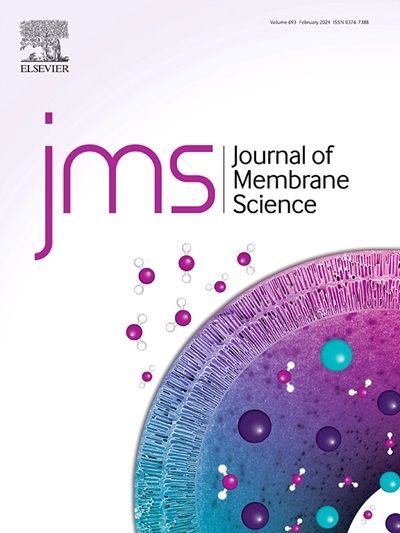Tailored design of mixed-linker MOF membranes for enhanced gas separation
IF 9
1区 工程技术
Q1 ENGINEERING, CHEMICAL
引用次数: 0
Abstract
Metal-organic framework (MOF) with narrow molecular-sized channels are attractive membrane materials for molecular-sieving gas separation. One of the greatest challenges currently facing MOF membranes is the development of appropriate membranes for specific mixture separation considering the matching of pore sizes. Postsynthetic linker exchange modification for precise control of the pore size could resolve this difficulty and endow MOF membranes with enhanced gas separation property. Herein, an economical and environment-friendly vapor phase linker exchange method is reported to introduce benzimidazole (ZIF-7 linker) and 2-imidazolecarboxaldehyde (ZIF-90 linker) to narrow and enlarge the effective aperture diameter of ZIF-8 framework, respectively. The as-prepared ZIF-8-7 membrane shows extraordinary molecular sieving effect with CO2/CH4 separation factor of 62, which soars around thirtyfold compared with the parent ZIF-8 membranes. Intriguingly, the mixed-linker ZIF-8-7 membrane suggests extraordinary long-term stability of more than 300 days. The C3H6 permeance of the hybrid ZIF-8-90 membrane has been enhanced by more than 10 times, while maintaining C3H6/C3H8 selectivity of over 30 which exceeds the requirements for commercial applications. The microstructural engineering and performance manipulation in this work has significantly broadened the separation efficiency of MOF membranes in different application scenarios.

量身定制的混合链接MOF膜,以增强气体分离
具有窄分子通道的金属有机骨架(MOF)是分子筛分气体分离中极具吸引力的膜材料。目前MOF膜面临的最大挑战之一是考虑到孔径的匹配,开发适合特定混合物分离的膜。通过合成后的连接剂交换修饰来精确控制孔径,可以解决这一难题,使MOF膜具有更好的气体分离性能。本文报道了一种经济环保的气相连接剂交换方法,通过引入苯并咪唑(ZIF-7连接剂)和2-咪唑甲醛(ZIF-90连接剂)分别缩小和扩大ZIF-8框架的有效孔径。制备的ZIF-8-7膜具有优异的分子筛分效果,其CO2/CH4分离因子为62,比母膜ZIF-8提高了30倍左右。有趣的是,混合连接体ZIF-8-7膜具有超过300天的长期稳定性。杂化ZIF-8-90膜的C3H6透过率提高了10倍以上,同时保持了C3H6/C3H8的选择性在30以上,超出了商业应用的要求。本工作的微结构工程和性能操纵大大拓宽了MOF膜在不同应用场景下的分离效率。
本文章由计算机程序翻译,如有差异,请以英文原文为准。
求助全文
约1分钟内获得全文
求助全文
来源期刊

Journal of Membrane Science
工程技术-高分子科学
CiteScore
17.10
自引率
17.90%
发文量
1031
审稿时长
2.5 months
期刊介绍:
The Journal of Membrane Science is a publication that focuses on membrane systems and is aimed at academic and industrial chemists, chemical engineers, materials scientists, and membranologists. It publishes original research and reviews on various aspects of membrane transport, membrane formation/structure, fouling, module/process design, and processes/applications. The journal primarily focuses on the structure, function, and performance of non-biological membranes but also includes papers that relate to biological membranes. The Journal of Membrane Science publishes Full Text Papers, State-of-the-Art Reviews, Letters to the Editor, and Perspectives.
 求助内容:
求助内容: 应助结果提醒方式:
应助结果提醒方式:


